|
Beginnings
By the late
1890s Sunbeam had made a name for itself selling
high quality, relatively expensive cycles at
Sunbeamland in Paul Street. This tradition would
continue when the decision was taken to manufacture
cars. |
|
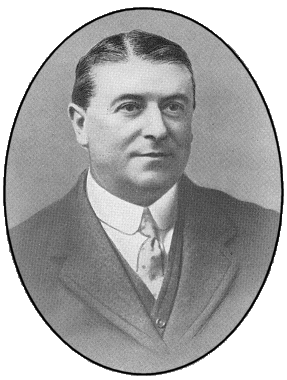
Thomas Cureton |
John Marston’s right-hand
man, Thomas Cureton, persuaded him to consider
building a car. They drew up a specification for an
experimental vehicle and work began on the prototype
in 1899.
The vehicle was built by Henry
Dinsdale, an ex-Wearwell man and expert engineer,
his assistant Harry Wood, then a boy, and other
members of staff at a disused coach-house in Upper
Villiers Street.
Edward Genna looked after the
office and would later become the company’s sales
manager. They used a fairly conventional design with
a 4hp. single vertical cylinder, water-cooled
engine, two speed gear, belt drive, and tiller
steering.
Most of the parts including
the radiator and spark plug were made at Sunbeamland
or machined there from locally made castings. |
|
John Marston must have been very keen on
the idea of building a car. Many of his friends pointed out to him that at his
age (he was 63 at the time) he shouldn’t waste a handsome fortune on the new
venture.
On completion, a road test was
organised. Dinsdale favoured the hilly route from Wolverhampton to Bridgnorth,
whereas Cureton decided on a journey from Wolverhampton to Stafford, which was
flat and included railway stations if necessary. They travelled at 14m.p.h., a
speed that they carefully kept hidden from John Marston.
|
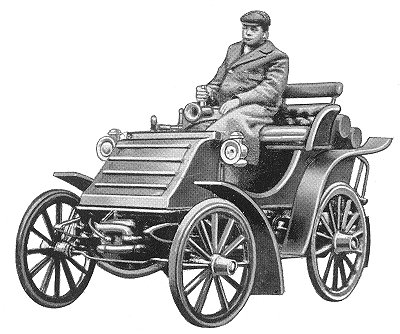
Sunbeam's first prototype car
of 1899 with James Morgan in the driving seat. |
|
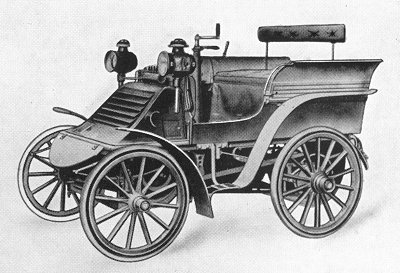
The company's second car,
built in 1900. |
A second and similar car was
produced in 1900 and exhibited at the National Show
at Crystal Palace in December, 1901. Like its
predecessor it was a two-seater, powered by a 4hp.
single cylinder, water-cooled engine with a normal
running speed of 700r.p.m.
It had two forward speeds
and a reverse drive to the rear wheels via an
adjustable belt. It had tiller steering, a separate
handbrake and pedal brake, and solid rubber tyres. |
| They also built a third car
of similar design that was produced in very small
numbers and offered with either a 6hp. or 8hp.
horizontal Forman twin cylinder, water-cooled
engine. The four-seater car had a conventional
steering wheel, three forward and a reverse gear,
and a chain drive to the rear wheels. Wooden
artillery wheels were used and fitted with
Clipper-Michelin tyres.
Another exhibitor at the 1901 National Show was Mr.
Maxwell Maberley-Smith, who had produced an unusual
car and decided to offer it to Sunbeam as a way for
them to enter the car market without any development
costs. Sunbeam accepted his offer and the
Sunbeam-Mabley was born. |
|
The unconventional vehicle had four wheels, one at the front,
one at the back, and two in the middle. It was shaped like an 's' sofa with a
seat on each side facing in different directions, and powered by a 2.75hp. De
Dion single cylinder, water-cooled engine. The
engine, mounted above the front wheel, drove the middle wheels by a leather belt
and chains. It had tiller steering on the front and rear wheels, pneumatic tyres
and a drum brake on each driving wheel. |
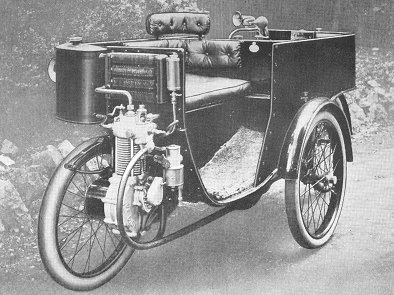
The
Sunbeam-Mabley. |
|
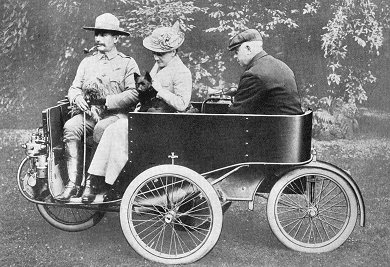
A Sunbeam-Mabley with driver
and passengers. |
The vehicles were built at a
car workshop in Sunbeamland with about 50 staff.
The car initially sold for
£140 including tools, lamp and horn, and the price
soon fell to £130.
Production continued
throughout 1902 and 1903, and about 130 were built. |
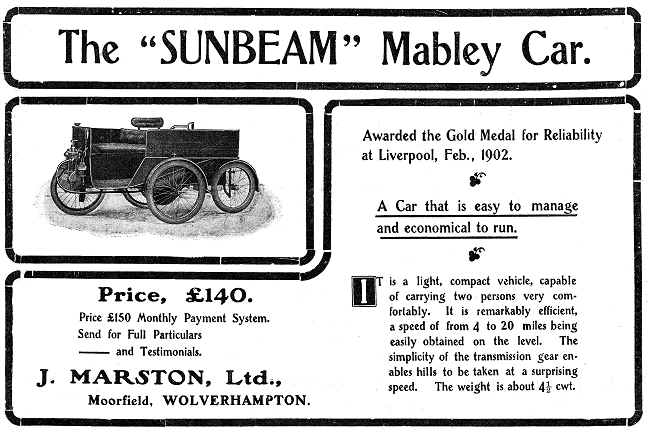
An advert from April 1903.
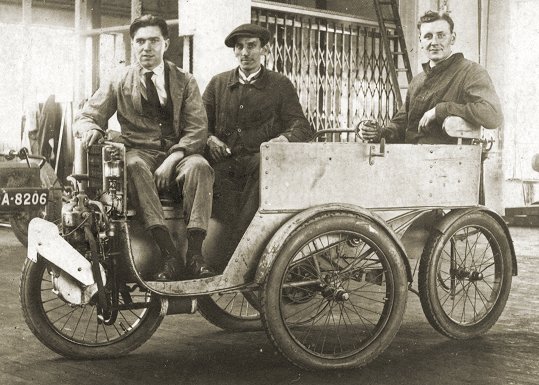
A Sunbeam-Mabley in the
Experimental Department at Moorfields in the mid
1920s. In the background is a 3 litre, 6-cylinder
Sunbeam sports model. Courtesy of Jim Boulton.
|
|
In 1901 Sunbeam displayed another car at
both the Edinburgh Show and the National Show. This was a 6hp. ‘Panhard’ type
with a body built by Forder, Wolverhampton’s famous carriage maker. It had many
bought-in parts and excellent write-ups in the press, where it was described as
“exemplifying high quality, with a steering wheel, and brakes of powerful
character”. The twin cylinder 6hp. car had three forward speeds that were
selected by a spring lever near the driver’s right hand.
Also in 1901
a piece of land was purchased in Upper Villiers
Street, next door to the Villiers Engineering
Company. The land, previously belonging to Japanware
manufacturer Edward Bullivant contained his garden
and an old coach-house which now became the factory.
It was extended by building a shed to house machine
tools. The machines were driven from overhead
shafting that came through the wall from the
adjacent Villiers Engineering Company. The factory
slowly expanded as galvanised iron buildings were
added. The original entrance was at the side of
Villiers’ building, along a passage and through part
of a garden, where the employees would pick lettuces
for tea.
|
| In 1902 Thomas Charles
Pullinger joined the company as Work’s Manager,
after working for several years on the design staff
at Darracq and other companies in France.
He persuaded Marstons to import partly completed
10/12hp. Berliet cars from France. Initially Sunbeam
purchased the complete car minus the body and slowly
purchased less and less of the car until only the
engine, gearbox and sub-frame were imported.
Ironically the car was first
shown at the Paris Motor Show in December 1903. |
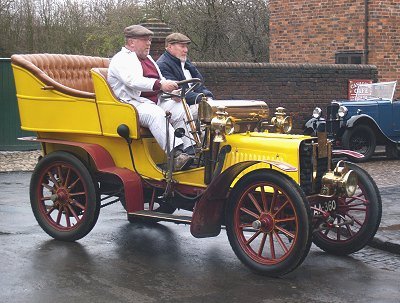
| A 1903 Sunbeam
with a Berliet engine, as seen at the
Black Country Living Museum, Dudley with
David Beere at the wheel and Stan Davis
in the passenger's seat. |
|
|
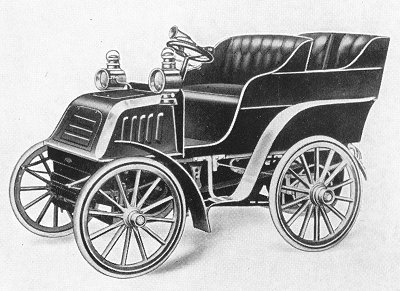
The car that was entered in
the 1902 London to Oxford Trial. |
Sunbeam cars were entered in
their first trials event, the 100 miles Liverpool
Reliability Competition in February 1902 in which
the company won the first prize, a gold medal.
In November of the same year a Sunbeam car entered
the London to Oxford Anniversary
run and received the diploma, providing the company
much coverage in the press. |
| The following year Sunbeam
entered cars in the London to Glasgow trial and yet
again, good publicity followed.
Even at this early date it seems that the company
had already discovered the benefits that such events
offered. |
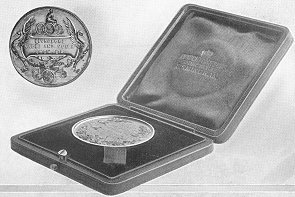
The gold medal won in the
Liverpool Reliability Competition of 1902. |
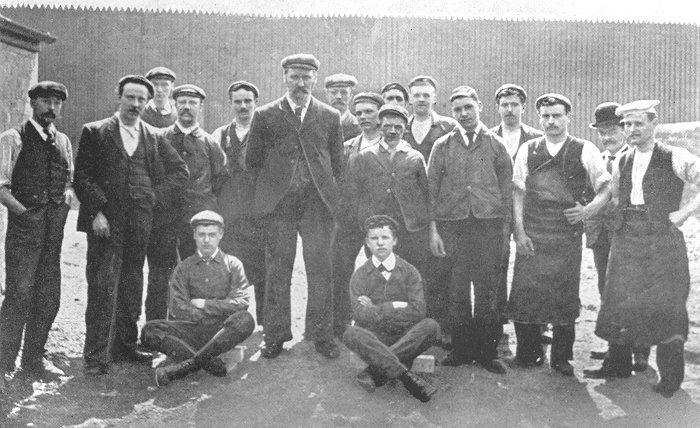
The staff in 1902.
Henry Dinsdale is the tall man in
the centre.
|
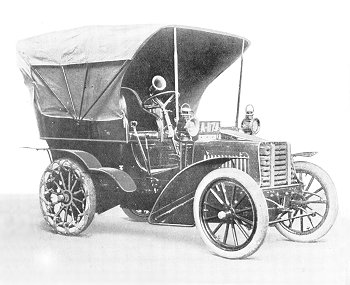
A 12hp. Sunbeam from 1903 with
a Capecart hood. |
1903 saw the introduction of
the Pullinger designed 10/12hp. Model, powered by a
2.4litre, 4 cylinder, water-cooled engine, with a
normal running speed of 800r.p.m.
The engine was cast in two blocks
of two that sat on a common aluminium crank case. It
had a leather-lined cone clutch, four forward and a
reverse gear, and a 1inch chain drive.
A six gallon
petrol tank was placed below the driver’s seat and
the chassis was built on ‘Panhard’ lines with a
central steel sub-frame carrying the engine and
gearbox, and ash side members with a dumb iron at
each end.
|
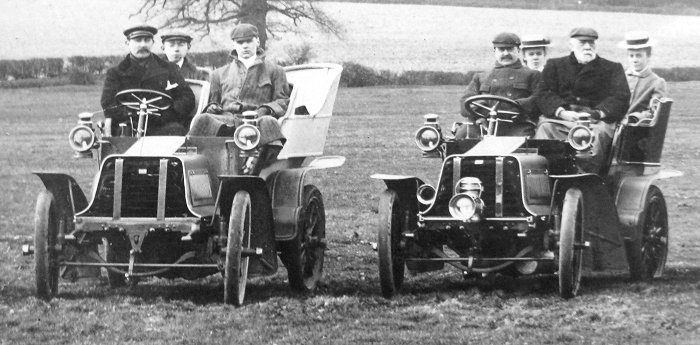
Two Sunbeam 10/12s at Wrottesley
Park, on 28th March, 1903. The one on the left is driven
by Thomas Pullinger, with Angus Shaw in the front
passenger seat. The one on the right is driven by Thomas
Cureton, with John Marston in the front passenger seat. |
| The car sold for 500guineas
and was the first Sunbeam car to be fitted with
their patent oil bath chain case. In 1904 the
prototype was successfully driven in the John
O'Groats to Land's End Trial by Fred Eastmead and 18
were built each month by 20 people. In all around 76
were built.
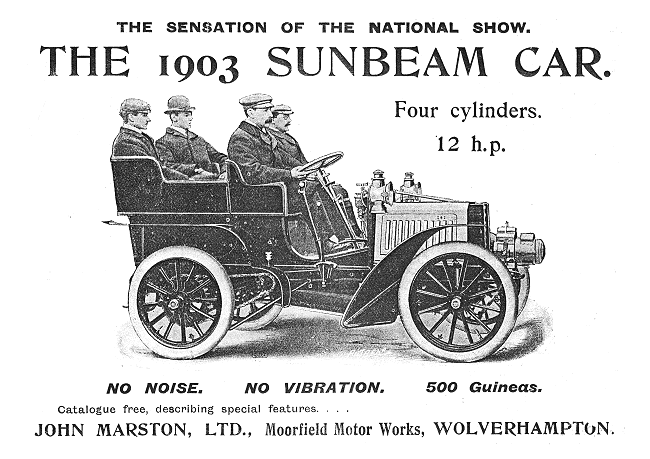
An advert from 1903 with
Thomas Pullinger at the wheel.
|
| Pullinger left in 1904 and
moved to Humber. He was replaced by Angus Shaw.
1904 also saw the introduction of the 16/18hp.
model, which featured a 3.6litre, 6 cylinder engine.
The cars sold quite well and it became necessary to
re-equip part of the works to expand production.
By
1904 a drawing office had been established and
building work had started at Villiers Street.
Because of the financial pressures this caused, it
was decided to turn this part of the business into a
separate company. |
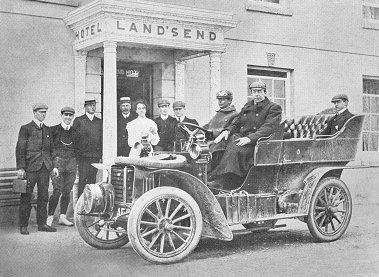
The 1904 prototype at the end
of the John O'Groats to Land's
End Trial. |
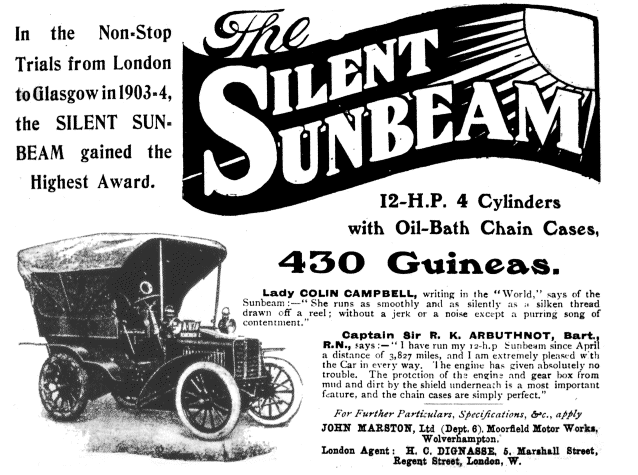
An advert from 1904.
|
The
“Autocar” magazine of February 13th, 1904
contains the following description of Sunbeam’s
exhibits at the Motor Show:
“In addition to the two-seater Mabley
and the 12/16 four cylinder Sunbeam, will be found a new six cylinder car;
cylinders cast in three rows; mechanically operated valves with variable inlet,
the cams being tapered so that variation is obtained by a sliding valve shaft; a
new metal to metal clutch running in oil, side brakes covered-in by the Sunbeam
chain case; complete under protection of the engine and gear, with the back so
formed to keep down dust.”
In October 1904 the first Sunbeam car
fitted with a dynamo to charge the accumulators for the electric lights was
introduced, and experimental work had started on a four cylinder 12/14hp.
design.
|
|
 |
|
 |
|
Return to
the beginning
|
|
Proceed to
the
Sunbeam Motor Car
Co. Ltd. |
|